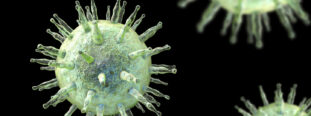Managing the ‘Tec Effect’
Tecfidera (dimethyl fumarate, or DMF) is one of the more popular options for people starting treatment. Two large clinical trials have shown that it’s effective in reducing relapses, inflammation in the brain and the progression of disability (Gold and colleagues. N Engl J Med 2012;367:1098-1107; Fox and colleagues. N Engl J Med 2012;367:1087-1097). But it’s popularity is largely attributable to the fact that it’s an oral medication that’s easier to take than an injectable.
The challenge is to keep taking it despite the side effects. The most common is flushing (a hot, prickly sensation), which affects more than one-third of people taking the drug (Gold 2012). This effect generally diminishes with time, although 1 in 4 may experience persistent problems (FDA summary review, Feb. 11, 2013). Some studies have suggested that flushing may be even more common: one MS centre in the U.S. found that 57% of people experienced flushing in their first month of Tecfidera, and that number rose to 71% after nine months of treatment (Chaves and colleagues. AAN 2015; abstract P3.241).
The other common problem is gastrointestinal effects, such as nausea/vomiting, diarrhea and stomach pain, which occurred in about 40% of people enrolled in trials (Phillips and colleagues. Mult Scler Relat Disord 2014;3:513-519). Again, in real life, a majority may develop this problem, although it does appear to get less frequent if you stay on the drug (Chaves 2015).
The question is: can you weather the side effects long enough to get the benefits? In Tecfidera trials, almost one-third of people dropped out (for a variety of reasons) before the end of the two-year studies. The same appears to be true in the real world. A U.S. MS centre reported that fully 25% of people taking Tecfidera stopped in the first year of treatment, primarily because of side effects (Vollmer and colleagues. AAN 2015; abstract P3.244). This is 3-4 times higher than the stopping rate reported in trials (12-16% over two years) (Gold 2012; Fox 2012).
So can anything be done to minimize this Tec Effect of flushing and gastrointestinal symptoms?
One strategy that’s often recommended to reduce flushing is to take an Aspirin (ASA) about 30 minutes before taking Tecfidera. A two-month study in healthy people found that this does work (O’Gorman and colleagues. Clin Ther 2015; epublished May 18, 2015). The frequency and severity of flushing were reduced and the Aspirin didn’t appear to cause stomach upset. A second study also reported that Aspirin was helpful (Sheikh and colleagues. Clin Ther 2013;35:1582-1594).
However, it’s important to note that Aspirin is hard on the stomach and liver. Tecfidera can also cause liver problems, so the combination isn’t a good long-term strategy. Talk to your doctor about the amount of Aspirin to take, and how long you can safely combine it with Tecfidera. An easier approach may be to take Tecfidera with food – one dose with breakfast and one dose at dinnertime. Food won’t change the effectiveness of the medication.
The second strategy tries to minimize gastrointestinal effects. When starting Tecfidera, dose titration is recommended, i.e. starting with a low dose, then gradually increasing the dose so your body has time to adjust. The product label says to start with 120 mg (the green and white capsule) twice a day. After one week, the dose should be increased to 240 mg (the green on green capsule) twice a day. Some doctors recommend an even slower titration schedule so that the effective dose (240 mg twice-daily) isn’t reached for 3-4 weeks (Nazareth and colleagues. ECTRIMS 2014; abstract P307).
In the O’Gorman study cited above, a slow dosing schedule was used: 120 mg once-daily in the first week, 120 mg twice-daily in the second week, 240 mg in the morning and 120 mg in the evening in the third week, and 240 mg twice-daily in the fourth week. Unfortunately, sneaking up the dose wasn’t helpful in reducing gastrointestinal upset (or flushing).
Dose titration does have a few downsides. Complicated titration schedules can cause confusion, and it may give the impression that fiddling with the dose is all right. But it’s important to keep in mind that a lower dose of Tecfidera will have little impact on your MS (Kappos and colleagues. Lancet 2008;372:1463-1472). So avoid staying on the reduced-dose schedule longer than your doctor has prescribed. The full dose is needed, and anything less is likely be a waste of time and money.
Taking Pepto-Bismol before Tecfidera may provide some stomach relief but it’s a mixed blessing. In the PREVENT study, Pepto-Bismol didn’t prevent bloating, and nausea and stomach pain were a little more common (Tornatore and colleagues. ECTRIMS 2014; abstract P052). But Pepto-Bismol did reduce the frequency of diarrhea and flatulence, and fewer people described their symptoms as severe. Various other medications may be used to manage the Tec Effect (Phillips 2014), but it hasn’t been determined yet if any of these strategies will work to relieve the flushing and stomach problems seen with Tecfidera.
For most people, side effects such as flushing and stomach upset aren’t medically serious, but they can jeopardize your chances of successful treatment if they keep you from taking the medication. If your MS therapy seems worse than your MS symptoms and you just can’t deal with the side effects, talk to your neurologist or MS nurse. They may be able to offer some solutions to improve your symptoms, or can recommend another medication that’s easier to take.
Share this article
Facebook Twitter pin it! Email
Related Posts
Back





